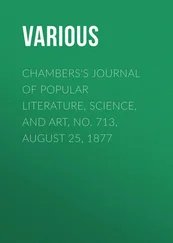Various - Chambers's Journal of Popular Literature, Science, and Art, No. 694
Здесь есть возможность читать онлайн «Various - Chambers's Journal of Popular Literature, Science, and Art, No. 694» — ознакомительный отрывок электронной книги совершенно бесплатно, а после прочтения отрывка купить полную версию. В некоторых случаях можно слушать аудио, скачать через торрент в формате fb2 и присутствует краткое содержание. Издательство: Иностранный паблик, Жанр: periodic, foreign_edu, на английском языке. Описание произведения, (предисловие) а так же отзывы посетителей доступны на портале библиотеки ЛибКат.
- Название:Chambers's Journal of Popular Literature, Science, and Art, No. 694
- Автор:
- Издательство:Иностранный паблик
- Жанр:
- Год:неизвестен
- ISBN:нет данных
- Рейтинг книги:5 / 5. Голосов: 1
-
Избранное:Добавить в избранное
- Отзывы:
-
Ваша оценка:
- 100
- 1
- 2
- 3
- 4
- 5
Chambers's Journal of Popular Literature, Science, and Art, No. 694: краткое содержание, описание и аннотация
Предлагаем к чтению аннотацию, описание, краткое содержание или предисловие (зависит от того, что написал сам автор книги «Chambers's Journal of Popular Literature, Science, and Art, No. 694»). Если вы не нашли необходимую информацию о книге — напишите в комментариях, мы постараемся отыскать её.
Chambers's Journal of Popular Literature, Science, and Art, No. 694 — читать онлайн ознакомительный отрывок
Ниже представлен текст книги, разбитый по страницам. Система сохранения места последней прочитанной страницы, позволяет с удобством читать онлайн бесплатно книгу «Chambers's Journal of Popular Literature, Science, and Art, No. 694», без необходимости каждый раз заново искать на чём Вы остановились. Поставьте закладку, и сможете в любой момент перейти на страницу, на которой закончили чтение.
Интервал:
Закладка:
Various
Chambers's Journal of Popular Literature, Science, and Art, No. 694 / April 14, 1877
THE COMING OBELISK
For more than fifty years we have heard of projects for bringing to England the prostrate obelisk lying on the sandy shore of Egypt at Alexandria, and popularly known as Cleopatra's Needle. Every successive scheme of this kind has come to nothing. When the French army quitted Egypt in 1801, the British officers, wishing to have some memorial of the victories of Sir Ralph Abercrombie, claimed the prostrate obelisk as a spoil of war, and formed a plan for bringing it to England. A ship was obtained, a mode of stowage planned, and a jetty built between the obelisk and the beach. The Earl of Cavan, in command of the troops, headed the scheme; Major Bryce, of the Royal Engineers, worked out on paper the details of the operation; while officers and men alike subscribed a certain number of days' pay to meet the expenses. The obelisk was to be introduced into the ship through the stern port, and placed on blocks of timber lying over the keel. But difficulties of various kinds arose and the scheme was abandoned.
Eighteen years afterwards the Pacha of Egypt, Mehemet Ali, presented the prostrate obelisk to the Prince Regent; the British government accepted the gift, but took no steps towards utilising it, being deterred by an estimate of ten thousand pounds as the probable cost of bringing the monolith to England. Thirty-three more years passed; the Crystal Palace Company was organising its plan for the costly structure and grounds at Sydenham; and a question was started whether Cleopatra's Needle would form an attraction to the place. Men rubbed up their reading to ascertain how the ancients managed to remove such ponderous masses as this. It is certain that the stone must have been quarried in Upper Egypt, and conveyed somehow down to Thebes, Alexandria, and other places in that classic land. Pliny describes a prostrate obelisk which was moved to a distance by digging a canal under it, placing two heavily laden barges on the canal, and unloading them until they were light enough to rise and lift the obelisk off the ground; it was then floated down the Nile on the barges, and landed and set up by the aid of a vast number of men with capstans and other apparatus. A plan was suggested to the Crystal Palace Company for bringing Cleopatra's Needle to England on a raft; but the idea was relinquished. Subsequently there were several projects for importing the obelisk; but they also fell through, after not a little eager expectation and talk. Thus, from one cause or other, the famed obelisk was left undisturbed, and what may be deemed British property still lies in a kind of buried state among the sands on the coast of Egypt. Luckily, it has not suffered injury by delay in removal. The stone is of a hard texture, and its entombment has been rather an advantage than otherwise. Although first and last there has been much said about Cleopatra's Needle, we shall attempt to give some account of it and of a freshly conceived plan for bringing it to England.
The ancient Egyptians excelled in the art of erecting magnificent temples, pyramids, obelisks, and other works in stone, all of which, or the ruins of them, fell into the hands of successive conquerors – Persians, Greeks, Romans, Arabs, and finally the Turks. Among the long roll of monarchs of the ancient Egyptians, one stands out conspicuously for grandeur of character and the splendour of his reign. That was Thothmes III., who flourished fourteen hundred and forty-four years before the commencement of our era, that is to say, three thousand three hundred and twenty years ago. He ordered to be executed two obelisks of gigantic dimensions for the City of On, or City of the Sun, the name of which was changed by the Greeks to Heliopolis, a word signifying the same thing. During the lifetime of Thothmes, the obelisks were cut out of the quarries of Elephantiné, which consist of the rose-coloured granite of Syene, or Es-souan. These obelisks were to be set up in front of the Temple of the Sun, and in however mistaken a way, must be viewed as a pious tribute to the Almighty, personified in the Sun as the author of Light and Heat, the fructifier and sustainer of animal and vegetable existence.
The preparation of the two obelisks was the work of years. Before their completion, Thothmes III. had passed away; and the honour of setting them up in their appointed place belonged to one of his successors, Rameses II., familiarly known to us as Sesostris. We can fancy the imposing ceremonies which took place in erecting the obelisks in front of the Temple of the Sun at Heliopolis. Both obelisks were inscribed with hieroglyphics, signifying that they were erected to the god Ra, or the Rising Sun, and to Tum, or the Setting Sun, which identify them with the most ancient and perhaps most poetical superstition in the world. To these hieroglyphics were added others by Rameses II., commemorative of certain military conquests.
And where is now Heliopolis, the City of the Sun, at which these grand obelisks were set up and venerated by the ancient rulers of the country? It is extinct. As in many other old Egyptian cities, its dwellings, built of unburnt bricks, have long since crumbled into heaps of dust. Its splendid monuments are destroyed or dispersed. When the Romans took possession of the country, the two obelisks that had been erected by Rameses II. in honour of the Sun were removed by the celebrated Cleopatra to grace the Cæsarium at Alexandria about the year 40. There, near the shore, they were set up. One of them remains where it was placed, and is a well-known landmark. The other fell, from what cause is unknown, and there it has lain till our times.
Such in brief is the history of Cleopatra's Needle. It is upwards of three thousand three hundred years old; and whether standing or lying, it has been at Alexandria for at least eighteen hundred and thirty years. How along with its fellow it was transported from Heliopolis to Alexandria, can no more be known than how the Pyramids were built. Doubtless, there would be an enormous expenditure of human toil; but at the time that was not regarded. Unfortunate beings captured in battle were condemned to slavery, and if they perished in dragging huge stones, no one cared. If Cleopatra's Needle could speak, it would tell of cruelties of which we can form no adequate conception.
The two obelisks were nearly of the same dimensions; and standing in their original position in front of the Temple of the Sun, they must have had a most imposing appearance. The prostrate obelisk, square in form, measures sixty-eight and a half feet long, six feet eleven inches wide on each side at the base, tapering to four feet nine inches near the summit, whence it narrows to a pyramidal point called the pyramidion.
We may have a pretty good idea of its appearance from that of the Luxor obelisk, set up on a pedestal in the Place de la Concorde at Paris, which is the same shape, and measures seventy-two feet three inches in height, exclusive of the pedestal of fifteen feet, and weighs five hundred thousand pounds. The cost of removing this obelisk from Luxor, near Thebes, to Paris, was about two millions of francs, or eighty thousand pounds. It is a handsome monolith, of reddish Syenite, but unfortunately it is damaged near the top, and suffers from the bad taste exhibited in the pedestal on which it was erected in 1836. In Rome there are a number of obelisks of different sizes that had been brought from Egypt by the Romans. Europe may be said to have come in for a fair share of these ancient monuments. There is room, however, for one more – Cleopatra's Needle, which, had matters been managed rightly, should long since have been brought to England and set up in the metropolis.
This brings us to the project now set on foot by Mr Erasmus Wilson, an eminent surgeon in London, and who has munificently undertaken to be at the entire cost of bringing the obelisk from Alexandria.
Читать дальшеИнтервал:
Закладка:
Похожие книги на «Chambers's Journal of Popular Literature, Science, and Art, No. 694»
Представляем Вашему вниманию похожие книги на «Chambers's Journal of Popular Literature, Science, and Art, No. 694» списком для выбора. Мы отобрали схожую по названию и смыслу литературу в надежде предоставить читателям больше вариантов отыскать новые, интересные, ещё непрочитанные произведения.
Обсуждение, отзывы о книге «Chambers's Journal of Popular Literature, Science, and Art, No. 694» и просто собственные мнения читателей. Оставьте ваши комментарии, напишите, что Вы думаете о произведении, его смысле или главных героях. Укажите что конкретно понравилось, а что нет, и почему Вы так считаете.







